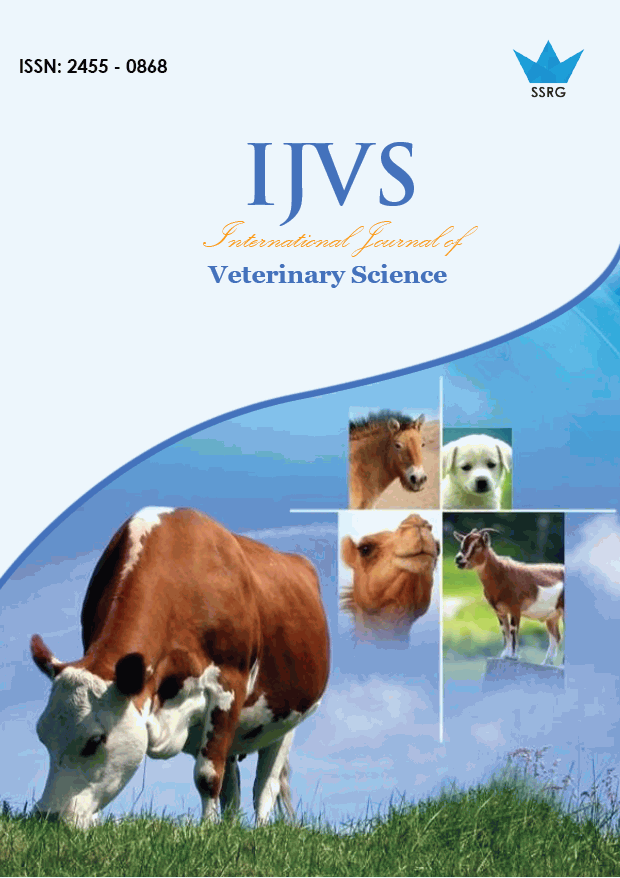Improvement of Conception Rate in Cows through Assessment of Semen used for Artificial Insemination Program at Government and Private Sector

| International Journal of Veterinary Science |
| © 2018 by SSRG - IJVS Journal |
| Volume 4 Issue 1 |
| Year of Publication : 2018 |
| Authors : Md.Humayon kabir, Md. Matiur Rahman, Md. Riadul Hasan, Dolan Das, Md.Salman Shahariar, Sobrata Das, Mst. Shumiya Khatun, Md. Jalal Uddin Sarder |
How to Cite?
Md.Humayon kabir, Md. Matiur Rahman, Md. Riadul Hasan, Dolan Das, Md.Salman Shahariar, Sobrata Das, Mst. Shumiya Khatun, Md. Jalal Uddin Sarder, "Improvement of Conception Rate in Cows through Assessment of Semen used for Artificial Insemination Program at Government and Private Sector," SSRG International Journal of Veterinary Science, vol. 4, no. 1, pp. 1-5, 2018. Crossref, https://doi.org/10.14445/24550868/IJVS-V4I1P101
Abstract:
The study was undertaken to investigate the semen quality of government and private sectors and to improve the conception rate of dairy cows. Laboratory methods of semen evaluation are used to select males for artificial insemination. The total dose adjusted conc. Million per ml was (123±27.3). The motility concentration of semen was higher in BRAC (30.16±18.98) and lower in ACI (8.72±0.77). The most significant things were that the motile percent of semen was higher in BRAC (49.40±9.76) and lower in MILK VITA (19.96±3.16). Abnormalities of sperm were varies in percentage. The highest abnormalities of semen were found in in PRAN Company (22.86±3.22) and lowest was in ACI (RAD) (13.24±1.80). Therefore, ACI (RDA) semen qualities are best among those companies or organizations. The higher conception rate was found in PRAN (65.68±10.35) and lower was in MILK vita (39.01±2.55) semen.
Keywords:
Artificial, Assessment, conception, insemination, semen.
References:
[1] Alam J., Livestock Resources of Bangladesh, Present Status and Future Potential, University Press Limited, 1995.
[2] Foote, R. H., The history of artificial insemination: Selected notes and notables. Journal of Animal Science, 80: pp 1–10, 2000.
[3] Brinsko, S. P. and Varner, D.D., Artificial insemination. In: A O McKinnon and J L Voss (editor) Equine Reproduction, pp 790-797, 1993. Lea and Febriger, Philadelphia, USA.
[4] Godfrey, R.W., Effect of season and location on semen quality and serum concentration of luteinizing hormone and testosterone in Brahman and Hereford bulls. Journal of Animal Science, 68: pp734-749, 1990.
[5] Lindford, E., Glover, F.A., Bishop, C. and Stewart, D.L., The relationship between semen evaluation methods and fertility in the bull. Journal Report of Fertility, 47: pp 283-291, 1976.
[6] Budworth, P.R., Amann, R.P. and Chapman, P.L., Relationships between computerized measurements of frozen- thawed bull spermatozoa and fertility. Journal of Andrology, 9: pp 41-54, 1988.
[7] Sorderquist, L., Sperm characteristics and fertility in dairy AI bulls. PhD Thesis, Department of Obstetrics and Gynaecology, Faculty of Veterinary Medicine, Swedish University of Agricultural Science, Uppsala, Sweden, 1991.
[8] Sullivan, During processing, quality of preserved semen can be influenced by the extender used . W.H. Freeman and Company , San Francisco. pp. 286-320, 1978.
[9] Amann, R. P., G. E. Seidel, Jr., and Brink, Z. A., Exposure of thawed frozen bull sperm to a synthetic peptide before artificial insemination increases fertility. J. Androl. 20:42–46.

 10.14445/24550868/IJVS-V4I1P101
10.14445/24550868/IJVS-V4I1P101